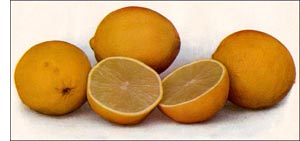Lime fruit
 The Lime belongs to the same genus of plants as the orange, lemon, grape fruit, and citron.
The Lime belongs to the same genus of plants as the orange, lemon, grape fruit, and citron. The lime, lemon, and citron are closely related and are now considered varieties of the same species, the Latin name of which is medica, named by the Romans for the country Media. This species is very valuable, having been greatly modified by cultivation.
The lime is the fruit of a bush or low tree which seldom grows higher than twenty feet. The tree will thrive in quite poor and rocky soil. It is more tender than most of the citrus fruits, and can withstand less cold than the lemon. Its cultivation has, for this reason, been abandoned in many localities where the sweet orange seems to thrive.
Several varieties of the lime are cultivated in the United States. The more important of these are the Mexican, which has a small and rather oblong fruit; the Persian, introduced from Persia, which bears a larger fruit; the Rangpur, introduced from India, which bears a fruit resembling the mandarine orange in that the rind is easily separable from the pulp and the carpels may be separated as in the orange. The most highly prized variety is the Tahiti, the fruit of which is quite large and nearly seedless.
In tropical countries limes are more highly prized than lemons for making cooling drinks. They are also used extensively for the manufacture of lime juice and citric acid. The lime is used as a flavor at soda fountains, and is also used to make a drink called limeade.
The juice of the lime is quite extensively used as a preventive of and as a remedy for scurvy. British sailors are sometimes called "lime-juicers," from the fact that "the law requires that the crews be furnished with a weekly allowance of the extract of limes or lemons, as a preventive of scurvy."
Lime picture